Menus
- Single vs. Four-cylinder
- Ballermann versus barrel organ
- KTM 690 Duke R follows comfortably
- In sixth passage through the village
- Suzuki GSR 750 cannot quite keep up in the sprint
- KTM 690 Duke R – what’s new?
- Technical data KTM 690 Duke R
- Technical data Suzuki GSR 750 ABS
- Readings
- rating
- Conclusion
- KTM 690 Duke and Suzuki GSR 750 in price comparison
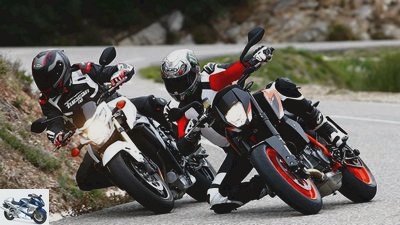
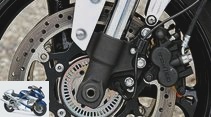
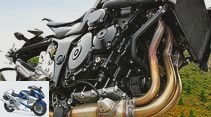
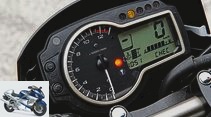
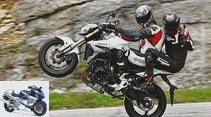
18th photos
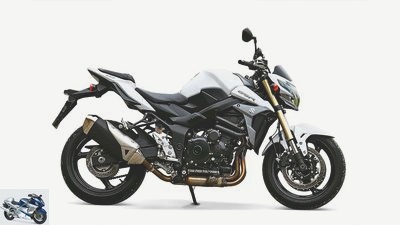
1/18
In the end, the Suzuki GSR 750 ABS had to admit defeat to the KTM 690 Duke R..
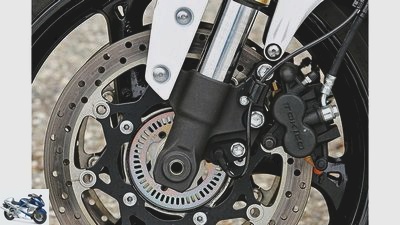
2/18
The double floating saddle system works rather bluntly, and the ABS controls very defensively. Tab damping of the fork.
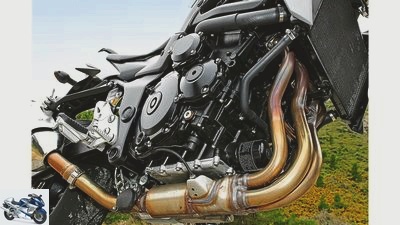
3/18
The four-cylinder comes from the GSX-R 750 and has been heavily redesigned for use in the naked bike and clearly tamed. He has lost almost a third of his performance.
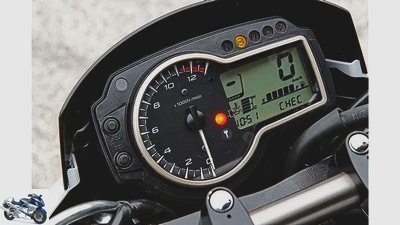
4/18
The cockpit display of the Suzuki GSR 750 is easy to read, but stingy with information. There are also no different mappings to choose from.
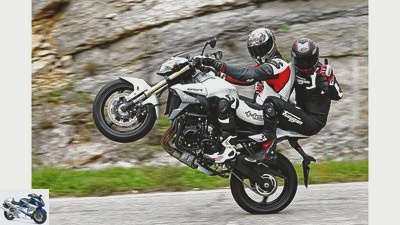
5/18
Can the Suzuki GSR 750 keep up anyway?
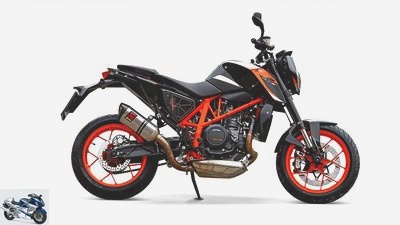
6/18
The KTM 690 Duke R is equipped with many electronic extras, but also costs significantly more than the Suzuki.
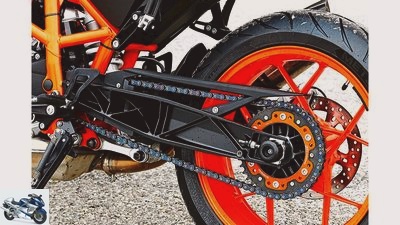
7/18
Fine parts: cast aluminum swingarm and two-part chainring. Inside aluminum, outside steel.
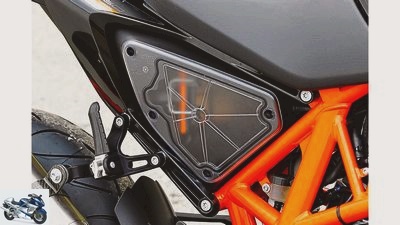
8/18
Somehow reminiscent of a Dyson vacuum cleaner, but it is quite practical: Airbox with a transparent lid for visual inspection.
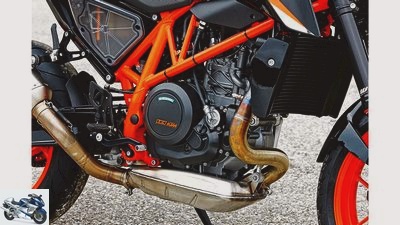
9/18
The engine is simply awesome. This combination of performance and smoothness has never been seen in a single cylinder.
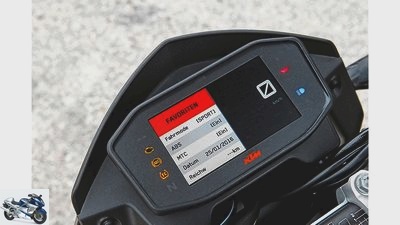
10/18
The cockpit displays can be changed using the left handlebar switch and the settings for ABS, traction control and mapping can be configured.
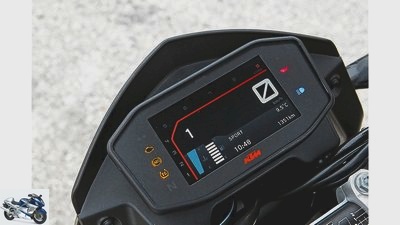
11/18
The main view of the TFT display.
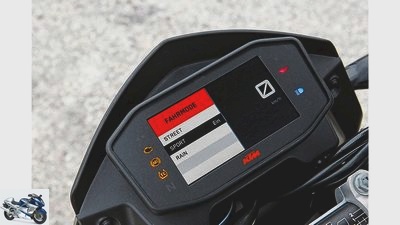
12/18
The KTM 690 Duke R has three mappings: Street, Sport and Rain.
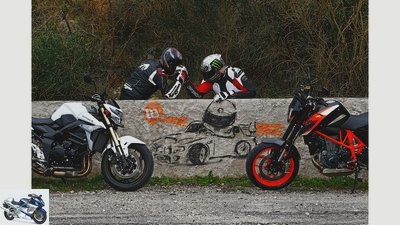
13/18
In both the Suzuki GSR 750 and the KTM 690 Duke R, every horsepower has to try to overcome the mass moment of inertia of almost exactly two kilograms. Let us first consider the KTM 690 Duke R..
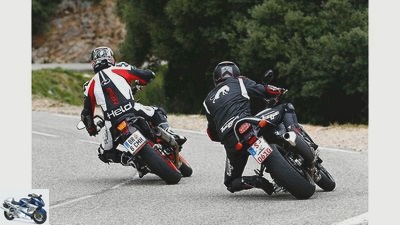
14/18
But there is one thing in common …

15/18
One against four cylinders, 75 against 106 hp, 10,295 against 8590 euros.
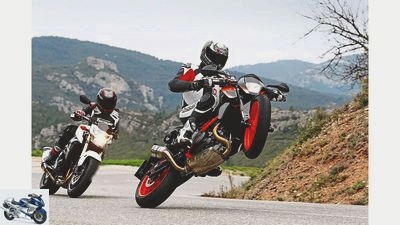
16/18
At first glance, there is little to be said for a comparison test between the two bikes.
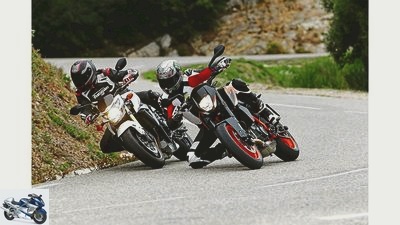
17/18
In the comparison test, the KTM 690 Duke R and the Suzuki GSR 750 compete against each other.
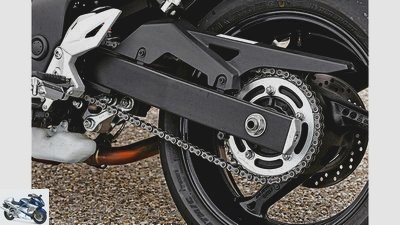
18/18
Steel, also painted black, is a popular material on the Suzuki, as here on the swingarm, chainring and exhaust.
KTM 690 Duke R and Suzuki GSR 750 in comparison test
Single vs. Four-cylinder
Content of
At first glance, there is little to be said for comparing these bikes. One against four cylinders, 75 against 106 hp, 10,295 against 8590 euros. But there is one thing in common between the KTM 690 Duke R and the Suzuki GSR 750: Each PS has the same weight to move.
While usually all good things are three, in this case the connecting element is two. For both the Suzuki GSR 750 and the KTM 6th90 Duke R, every horsepower has to try to overcome the mass moment of inertia of almost exactly two kilograms. The way in which this happens could hardly be more different. Inset: The R-lose Duke, which is 1900 euros cheaper, has the same power-to-weight ratio, but on the one hand we’re here at PS, and on the other hand: Why should you date Claudia Roth when you can also have Sarah Wagenknecht? A weird comparison, admittedly, so back to the topic.
Buy complete article
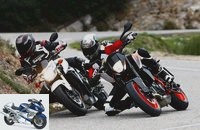
KTM 690 Duke R and Suzuki GSR 750 in comparison test
Single vs. Four-cylinder
The peak is reached at 11,400 rpm
At least as long as you give the four, which is supplied by a double throttle valve system, the spurs. Although it delivers its power evenly and always accompanied by light, high-frequency vibrations, the breeze is rather mild up to 5000 rpm. But then he rolls up his sleeves to energetically storm forward from 8000 rpm. The peak is then reached at 11,400 rpm. But whoever sows speed will reap gear changes! And load changes! The stitching in the six-stage rear derailleur of the Suzuki GSR 750 is easy to do, pardon your feet, but the detent should be more precise.
It is necessary at the latest when the KTM 690 Duke R is part of the party. What the Austrians have made of the single, which was heavily revised for 2016, is simply inspiring (see also on the next page “KTM 690 Duke R – what’s new?”). From the concept-related hacking under 3000 tours, in high gears also under 4000 times, the big single is very good at denying its single-cylinder nature. With unimaginable liveliness and spontaneity with series stews, it turns greedily and powerfully until the limiter puts an end to the hustle and bustle at 9000 rpm.
Ballermann versus barrel organ
Except for the Akrapovic muffler, the drive of the KTM 690 Duke R is identical to the standard version. In contrast to the chassis and brakes. Front and rear, apart from the preload of the upside-down fork, fully adjustable WP components ensure a fine response, clear feedback and crisp damping. The bustling handling of the KTM is unbelievable. It reacts to the smallest of impulses. Compared to the Suzuki GSR 750, which is not exactly sluggish, the Duke rides like the proverbial bicycle.
With the forced chase through the Winkelwerk, the matter is then as follows: In front the Suzuki GSR 750, whose pilot fights with great concentration against the inadequacies of the components, which are probably bought quite cheaply. The front brake acts very bluntly, and the ABS, which cannot be switched off, regulates very defensively, which means much too early. Malicious tongues claim that it is primarily concerned with releasing the brake and not with closing it. The suspension, which can only be adjusted in terms of the spring preload at the front and rear, is generally tightly tuned, but is not particularly sensitive to the rear. With the upside-down fork, the damping quickly reaches its limits. The relatively high weight of the GSR requires a lot of effort in fast changing turns. They circled them with neutral driving behavior until the footpegs gently grazing over the asphalt warn the end of the sloping drift.
KTM 690 Duke R follows comfortably
Meanwhile, the Duke pilot drives comfortably behind and is happy about his box seat. He wonders whether he should show the front wheel to the front wheel to the right or the left in order to demoralize him. The KTM 690 Duke R, fitted with Metzeler M7 RR tires, turns when the thigh is pressed, and remains neutral and predictable down to the deepest lean angles. Whether pressing in an inclined position or hanging-off, it goes along with everything. The KTM 690 Duke R has three mappings: Street, Sport and Rain. They not only influence the characteristics of the engine, but also the operation of the banking-dependent traction control and the ABS.
We immediately switched off the rain mode on the test motorcycle; it recognized a need for regulation where there was definitely none. As soon as there was even a slight lean angle, it immediately noticeably cut performance when accelerating. The same route went with the same driving effort and at the same speed in road mode without problems and correctly without any intervention by the electronics. The sport mode is primarily noticeable through a hard throttle response and corresponding load change reactions. In the time available, it was not possible to find out whether the system on the test motorcycle was malfunctioning or whether the behavior should be classified under the heading “It’s not a bug, it’s a feature”.
In sixth passage through the village
Nonetheless, if you have the same driving skills, it is easy to follow the Suzuki with the KTM. Conversely, it is a demanding task. On the one hand. On the other hand, the Suzuki GSR 750 presents itself on this side of the “Highway to Hell” mode as the more digestible, because less aggressive motorcycle. In sixth passage through the village? No problem. Okay, great acceleration is not to be feared at the end of the town, but the seals remain in place. Pulling through from low engine speeds is definitely not the parade discipline of the KTM 690 Duke R. Your single always wants to be kept above 3000 rpm. Although this switch box needs to be operated with a little more care and emphasis than with the Suzuki, the gears should sit correctly.
The driver sits very comfortably on it himself. In direct comparison to the Suzuki GSR 750, it does not seem to have a tank, the knee joint is so narrow. The upper body is even more upright than on the GSR. Overall, the KTM 690 Duke R offers a lot of space for gymnastics. The GSR leaves its rider less room for physical exercise, behind the high and wide tank you sit in rather than on the bike. You can stop at an ordinary tubular handlebar. The brake is controlled by a conventional pump, the lever is adjustable. Overall, the GSR is already noticing the cost pressure. In addition to the spring elements already mentioned, the floating calipers, as well as the rocker arm and exhaust made of steel that is as disgusting as it is heavy, stand out.
Suzuki GSR 750 cannot quite keep up in the sprint
This is where the “ERR” comes in: tapered handlebars, radial brake pump, monoblock brake calliper and color TFT display with night mode are not only pleasing to the eye. The standard version also has the fine, cast aluminum swing arm, but not the aluminum side stand. The abundant Torx screws looked much higher quality in earlier years
Nevertheless, the KTM 690 Duke R remains an expensive as well as fascinating, radical planer for the fast lap on Sunday mornings on roads with as little traffic as possible. The Suzuki GSR 750 cannot quite keep up in the sprint, but is the more manageable bike over a distance and in daily use, which is also economical with monetary resources.
KTM 690 Duke R – what’s new?
The engine of the KTM 690 Duke R is simply awesome. This combination of performance and smoothness has never been seen in a single cylinder.
engine
- 4.5 mm shorter stroke (bore / stroke 105/80 mm instead of 102 / 84.5 mm)
- Peak power increased from 70 to 75 hp
- Second balancer shaft
- Valve train changed (the camshaft actuates the inlet valves directly via rocker arms and the exhaust valves via a fork rocker arm)
- Resonance chamber in the intake tract for a more homogeneous gas flow
- Intake cross section enlarged from 46 to 50 mm
- The engine speed limit increased from 8400 rpm to 9000 rpm
- Secondary air system
Technical data KTM 690 Duke R
The KTM 690 Duke R is equipped with many electronic extras, but also costs significantly more than the Suzuki.
KTM 690 Duke R (2016)
drive
Single-cylinder four-stroke engine, four valves, 55 kW (75 PS) at 8000 / min *, 74 Nm at 6500 / min *, 693 cm³, bore / stroke: 105.0 / 80.0 mm, compression ratio: 12.7: 1 , Ignition / injection system, 50 mm throttle valve, hydraulically operated multi-disc oil bath anti-hopping clutch, six-speed gearbox, G-Kat, chain, traction control
chassis & Brakes
Steel tubular frame, steering head angle: 63.5 degrees, caster: 122 mm, wheelbase: 1466 mm, upside-down fork,
Inner fork tube: 43 mm, adjustable in rebound and compression. Central spring strut with deflection, adjustable in spring base, rebound and compression. Suspension travel front / rear: 150/150 mm, cast light alloy wheels, 3.50 x 17 / 5.00 x 17, front tires: 120/70 ZR 17, rear: 160/60 ZR 17, first tires: Metzeler M7 RR, 320 mm disc brakes with radially attached four-piston monoblock fixed caliper at the front, 240 mm disc with single-piston floating caliper at the rear, ABS, traction control
performance
Max. Rear wheel power ** 51 kW (69 PS) at 195 km / h
Acceleration** 0-100 km / h: 3.8 s; 0-150 km / h: 7.7 s; 0-200 km / h: —-
Draft** 50-100 km / h: 6.6 s; 100–150 km / h: 6.0 s
Top speed * 188 km / h
measurements and weight Length / width / height: 2100/900/1300 mm, seat / handlebar height: 850/1110 mm, handlebar width: 795 mm, 165 kg fully fueled, v./h .: 49.8 / 51.2%
consumption Fuel type: Super unleaded. Average test consumption: 6.6 liters / 100 km, tank capacity 14 liters, range: 210 km
Set up
Setup fork stat.neg. Spring travel: 28 mm, compression: 12 K open, rebound: 15 K open
Setup shock absorber stat.neg. Spring travel: 20 mm, compression: low 20 K open, high fully open, rebound: 14 K open
Base price 10,295 euros, test machine: 10,295 euros (plus additional costs)
all damping settings counted from completely closed; static negative spring deflection standing vertically without driver; U = revolutions; K = clicks * manufacturer information ** PS measurement
Technical data Suzuki GSR 750 ABS
The four-cylinder Suzuki GSR 750 comes from the GSX-R 750.
Suzuki GSR 750 ABS
drive
Four-cylinder in-line engine, four valves / cylinder, 78 kW (106 PS) at 10,000 rpm *, 80 Nm at 9000 rpm *, 749 cm³, bore / stroke: 72.0 / 46.0 mm, compression ratio: 12.3 : 1, ignition / injection system, 32 mm throttle valves, mechanically operated multi-disc oil bath clutch, six-speed gearbox, G-Kat, chain
chassis & Brakes
Bridge frame made of tubular steel, steering head angle: 64.8 degrees, caster: 104 mm, wheelbase: 1450 mm, upside-down fork, Ø fork inner tube: 41 mm, adjustable in spring base. Central spring strut with deflection, adjustable in the spring base. Spring travel front / rear: 120/135 mm, cast light alloy wheels, 3.50 x 17 / 5.50 x 17, front tires: 120/70 ZR 17, rear: 180/55 ZR 17, initial tires: Bridgestone BT 016 “EE”, 310- mm double disc brake with double-piston floating calipers at the front, 240 mm single disc with two-piston floating caliper at the rear, ABS
performance
Max. Rear wheel power ** 72 kW (98 PS) at 212 km / h
Acceleration** 0-100 km / h: 3.3 s; 0-150 km / h: 6.3 s; 0-200 km / h: 12.5 s
Draft** 50-100 km / h: 5.4 s; 100–150 km / h: 5.3 s
Top speed * 225 km / h
measurements and weight Length / width / height: 2110/850/1250 mm, seat / handlebar height: 810/1020 mm, handlebar width: 700 mm, 214 kg fully fueled, v./h .: 51.1 / 48.9%
consumption Fuel type: Super unleaded. Test consumption: 7.2 liters / 100 km, tank capacity 17.5 liters, range: 240 km
Set up
Setup fork stat.neg. Spring travel: 19 mm, preload: 2 rings visible
Setup shock absorber stat.neg. Spring travel: 15 mm, preload 4 of 5 levels
Base price 8,590 euros, test machine: 8,590 euros (plus additional costs)
all damping settings counted from completely closed; static negative spring deflection standing vertically without driver; U = revolutions; K = clicks * manufacturer information ** PS measurement
Readings
Power on the crankshaft, measurements on Dynojet roller dynamometer 250.
It is absolutely crazy what the Austrians are getting out of the single cylinder today. The test bench certifies measured, presumably stable 78 hp at 8300 rpm. The smooth curve of the KTM 690 Duke R is also pleasing. It is easy to do without the range below 3000 rpm. The curves of the Suzuki GSR 750 are also almost exemplary, although not so impressive. This table does not show the high consumption levels determined in this test. They are explained by the fact that, as an exception, they also include the consumption-intensive photo trips.
rating
In the end, the KTM 690 Duke R achieved a total of 177 points and clearly beats the Suzuki GSR 750.
Max. Points
KTM 690 Duke R.
Suzuki GSR 750 ABS
Conclusion
Two winners! But in the comparison test there can only be one winner.
1st place – KTM 690 Duke R: The Duke R is the clear winner on points in this comparison. With all the electronic helpers, it is not only much better equipped than the Suzuki, the chassis components and a number of components such as brake calipers, swingarm, levers, notches, etc. are also of much higher quality. The driving characteristics are in a class of their own. However, the KTM 690 Duke R also costs 1705 euros more.
2nd place – Suzuki GSR 750 ABS Second winner is first loser? You don’t have to look at it that way, because the PS-specific requirements play into the hands of the extremely designed R version of the Duke. When comparing the Suzuki GSR 750 with the almost equally expensive standard Duke, the cards are reshuffled. Nevertheless, there is still some room for improvement with the GSR when it comes to suspension elements and brakes. The drive, on the other hand, is quite convincing. Easily accessible in everyday life, and when it comes down to it: shift down two gears, let the organ work and off you go!
KTM 690 Duke and Suzuki GSR 750 in price comparison
1000PS marketplace app
A large selection of naked bikes can be found on the used market.
Regardless of whether the heart beats for single-cylinder or four-cylinder – there is a large selection on the used market. Both the KTM 690 Duke and the Suzuki GSR 750 can be found many used copies that are looking for a new owner. A price comparison is available here: used KTM 690 Duke and Suzuki GSR 750 in Germany.
Related articles
-
Comparison test BMW K 1300 S, Kawasaki ZZR 1400, Suzuki Hayabusa 1300
Gargolov Comparison test BMW K 1300 S, Kawasaki ZZR 1400, Suzuki Hayabusa 1300 Speed bikes in comparison The wind tunnel formed their faces, their…
-
Suzuki V-Strom 650 and Suzuki V-Strom 1000 in comparison test
fact 8th photos fact 1/8 With a torque plateau already starting at 3500 rpm, the test bench also demonstrates the punch of the Suzuki V-Strom 1000 in the…
-
Comparison test Honda CB 650 F, Yamaha TRX 850, Suzuki SV 650 S and Yamaha MT-07
fact 21 pictures fact 1/21 A huge boost to the parallel twin: the registered flat slide carburetor from Mikuni. fact 2/21 Despite the changed …
-
BMW, Ducati, Suzuki and Triumph super sports cars in a comparison test
29 photos 1/29 Triumph Daytona 675, Ducati 848 Evo Corse SE, BMW S 1000 RR, Suzuki GSX-R 750. Different bikes – different cubic…
-
Kawasaki ER-6n and KTM 690 Duke in comparison
14th photos 1/14 Two middle class naked bikes in the verifying test. In the end, who is ahead of the game – the Kawasaki ER-6n…
-
Comparison test touring enduro bikes: Honda Transalp, Kawasaki Versys, Suzuki V-Strom 650
Jahn comparison test travel enduro: Honda Transalp, Kawasaki Versys, Suzuki V-Strom 650 Always on the wall, travel enduro does not necessarily mean BMW …
-
Comparison test: KTM Super Duke R against MV Agusta Brutale 990 R
Comparison test: KTM Super Duke R against MV Agusta Brutale 990 R Sporty naked bikes in the test Content of A feast for the senses: The new MV …
-
Comparison test KTM Duke against MuZ Mastiff
Comparison test between KTM Duke and MuZ Mastiff Must be fun Who says that a serious comparison test shouldn’t also be murderous fun. KTM …
-
Aprilia Tuono V4 R APRC ABS and KTM 1290 Super Duke R in comparison
Jahn 27 photos Jahn 1/27 Jahn 2/27 All information is easy to read and easy to understand. Great infotainment à la KTM. Jahn 3/27 Oops, how did this…
-
KTM 690 Duke R comparison old against new
fact 14th photos fact 1/14 You just can’t help it: two brisk singles always ask to dance. fact 2/14 2016: 690 Duke R 693 cc, 75 hp, 74 Nm. A second…